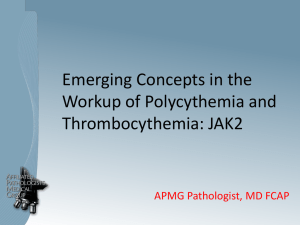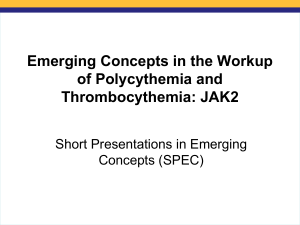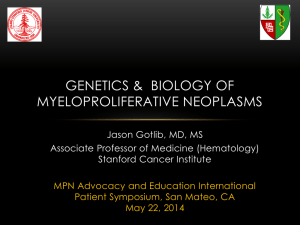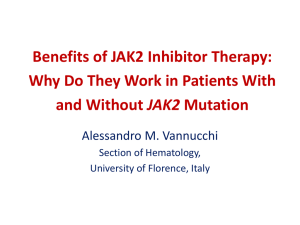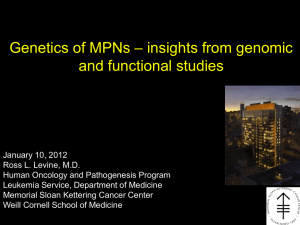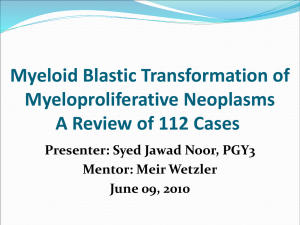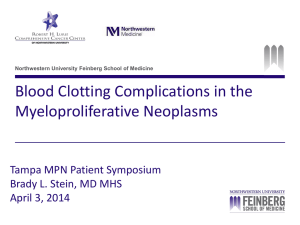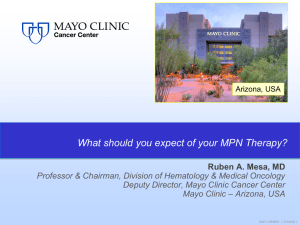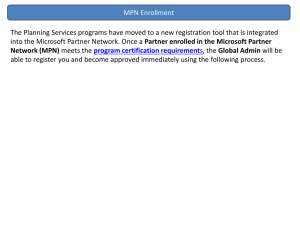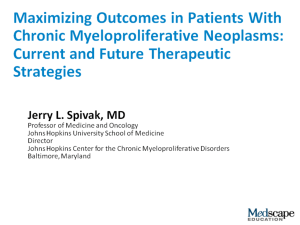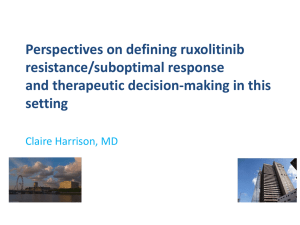Dr. Raajit Rampal, MD, Ph.D
advertisement
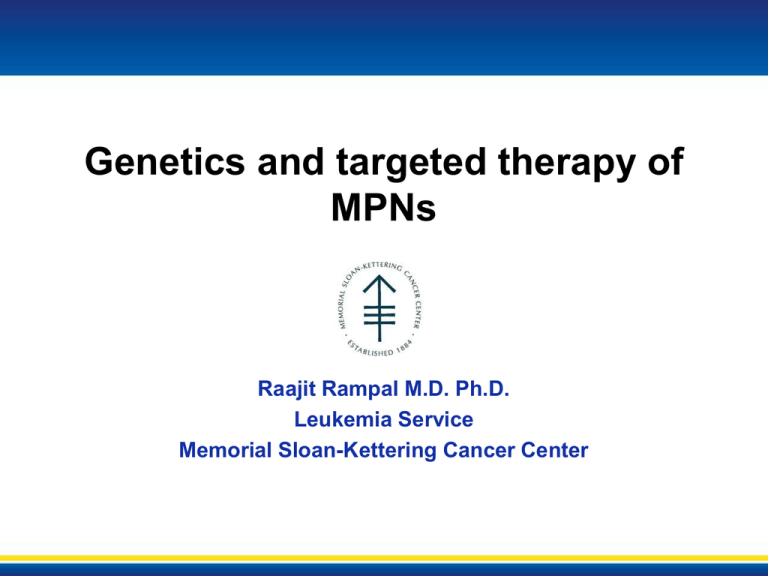
Genetics and targeted therapy of MPNs Raajit Rampal M.D. Ph.D. Leukemia Service Memorial Sloan-Kettering Cancer Center Scientific Questions/Advances • Are mutations which activate JAK2 a hallmark of all MPN patients? • What do mutations which occur in concert with JAK2/MPL mutations do? • What have we learned about JAK2 inhibitors? • What novel therapies are of potential benefit for MPN patients? JAK2V617F mutations in myeloid malignancies Prevalence of JAK2V617F : - PV: 95% - ET: 45-50% - MF: 45-50% - CMML: 5% - MDS: RARS-T (>50%) - AML: 2% James et al. Nature 2005 Levine et al. Cancer Cell 2005 Baxter et al. Lancet 2005 Kralovics et al. NEJM 2005 Zhao et al. JBC 2005 JAK2V617F negative MPN • JAK2V617F-negative PV - JAK2 exon 12 mutations - loss of function mutations in LNK, negative regulator of JAK2 (Oh et al Blood 2010) • JAK2V617F-negative ET/PMF - MPL mutations in 10% - LNK mutations in <5% • Somatic mutations had not been identified in 30-40% of MPN patients Identification of CALR Mutations in JAK2 wildtype MPN Klampfl et al NEJM 2013 Nangalia et al NEJM 2013 • CALR Mutations exclusive of JAK2/MPL mutations • Seen exclusively in ET/MF • Small set (<10%) of ET/MF patients JAK2/MPL/CALR-negative>unknown mutant disease allele Gene expression – can we measure gene expression and learn something about pathogenesis of MPN? • Determine if there is a common genetic signature associated with MPN or with JAK2V617F mutations • Identify genes which segregate with clinical phenotype • Identify candidate genes in JAK2/MPL/CALR-negative MPN Ben Ebert/Todd Golub Gene Expression Profiling of MPN Samples distinguishes MPN patients from controls but does not distinguish based on disease or JAK2 status Homozygous Heterozygous JAK2 negative Control PV PMF ET Is there a JAK2 signature in heterozygous/WT MPN patients? CONTROL JAK2 shRNA in HEL cells to generate JAK2 signature JAK2 expression 1500 1000 500 0 LUC Control GFP Control shRNA1 JAK2 shRNA2 JAK2 Similar data with JAK inhibitor JAK2 shRNA JAK2 shRNA signature in MPN and control samples HOMOZYGOUS PV MMM WT ET HETEROZYGOUS MMM ET CONTROL MMM Seen in all MPN patients, not in controls JAK2 is activated in all MPN patients regardless of specific mutation JAK2 Signature Enriched in CALR-mutant MPN Patients JAK2 shRNA down expression signature Homozygous vs Normal UP signature 0.5 Enrichment Score (ES) Enrichment Score (ES) 0.6 0.7 0.6 0.5 0.4 0.3 0.2 0.1 0.0 Normal CALR mutant FDR qvalue= 0.012 • 0.4 0.3 0.2 0.1 0.0 Normal CALR mutant FDR qvalue= 0.321 P-value= 0.035 Consistent with activated JAK2-signaling in CALR-mutant patients Enrichment Score (ES) Gene Expression Signature of CALR Mutation • CALR Signature is Enriched in JAK2-mutant MPN patients 0.8 0.7 0.6 0.5 0.4 0.3 0.2 0.1 0.0 Normal Homozygous FDR qvalue= 0.002 • Consistent with JAK2 and CALR mutations having same role in MPN pathogenesis – all leads to JAK2 activation Cooperating Mutations in MPN Patients • Recent studies have identified somatic disease alleles which occur in concert with JAK2/MPL mutations - TET2 loss of function mutations in 10% of MPN patients - ASXL1 mutations in 8-10% of MPN patients - IDH1/2 mutations in 3-5% of MPN patients - EZH2 mutations in 10-15% of patients • Same mutations are seen in MDS and AML patients->they do not explain the PV/ET/MF concondrum • In some cases (TET2, IDH1/2) these mutations occur most commonly at progression to AML • Limited functional data suggest these mutations affect the epigenetic state of MPN cells->affect the way DNA is packaged and which parts of it are used in MPN cells Leukemic Transformation of MPN • Patients with PV, ET, and PMF are at high risk for transformation to AML -associated with a dismal prognosis • Genetic/Epigenetic events which contribute to leukemic transformation are not known • Approximately 50% of JAK2+ MPN patients transform to a JAK2-negative MPN* *Campbell et al. Blood 2006 Theocarides et al. Blood 2007 Mutational Studies in post-MPN AML No mutations found in c-KIT, EZH2, or WT-1 Splicesome mutations Denotes frequently mutated in de novo AML Model of MPN Pathogenesis JAK2 rs10974944 Other alleles EZH2, TET2, ASXL1 • Mutations which activate JAK2 are the most common lesion->best therapeutic target • Possible other mutations affect response to JAK inhibitors TET2, IKZF, IDH1/2 Other Alleles AML JAK Inhibitors in Current Clinical Development Agent Company Activity Status Ruxolitinib (INCB18424) Novartis/Incyte JAK1/JAK2 FDA approved, Phase II (PV) TG101348/SAR302503 Sanofi Aventis JAK2, FLT3 Phase III CYT387 Cytopia JAK1/JAK2/TYK2 Phase II Pacritinib (SB1518) SBio JAK2, FLT3 Phase III Lestaurtinib (CEP701) Cephalon JAK2/Flt3 Phase I BMS-911453 Bristol-Myers Squibb JAK2 Phase I NS-018 Nippon-Shinyaku JAK2/Src Phase I AZD1480 Astra Zeneca JAK1/JAK2 Phase I LY2784544 Eli Lily JAK2V617F Phase I Tofacitinib (CP-690550) Pfizer JAK3 FDA approved (RA) • Although structurally divergent, these inhibitors are all Type I (ATP competitive) JAK Inhibitors Courtesy of Priya Koppikar Resistance to JAK inhibitors in the treatment of MPNs Phase II/III clinical trials with INCB18424 and other JAK inhibitors • Improvement in splenomegaly, constitutional symptoms, reduced progression to leukemia, survival benefit. • No decrease in allele burden in the majority of MPN patients • May be due, at least in part to presence of other (disease-initiating) alleles JAK2-driven preclinical models argue other factors contribute • JAK2V617F knockin model: Disease initiating cells are resistant to JAK2 inhibitor treatment (Mullally et al. 2010) MPN mutant clone persists in the presence of chronic JAK2 kinase inhibition We have not identified second-site mutations in patients treated with INCB18424 The lack of an initial response argues for inherent insensitivity to JAK inhibitors: persistence Reactivation of JAK2/JAK-STAT signaling Activation of a redundant/collateral pathway JAK-STAT signaling in naïve MPN cells JAK2 P JAK2 P STAT P P P RAS PI3K P MAPK AKT Nucleus STAT STAT P JAK inhibitors block homodimeric JAK2 activation and downstream signaling in naïve cells JAK2 RAS JAK2 PI3K STAT MAPK AKT Nucleus JAK-STAT Signaling is Intact in Patients Treated with Ruxolitinib INCB18424 Treated Untreated Pt-3 Pt-4 - + - + - Pt-2 Pt-1 Pt-5 + - + - Pt-9 + - + INCB18424 pSTAT3 STAT3 pSTAT5 STAT5 Koppikar et al. Nature 2012 JAK inhibitors cannot inhibit heterodimeric JAK2 activation and downstream signaling in persistent cells JAK1/ TYK2 JAK2 P P STAT P P P RAS PI3K P MAPK AKT Nucleus STAT STAT P pJAK2 Associates with JAK1 and TYK2 in MPN Patients treated with Ruxolitinib, but Not in Inhibitor Naïve Patients IN tx Pt-1 Pt-2 Pt-3 Untreated Pt-4 Pt-5 Pt-6 IN tx Pt-7 Pt-8 Pt-9 pJAK2 IP: JAK1 JAK2 JAK1 pJAK2 IP: TYK2 JAK2 TYK2 • • Do persistent cells remain JAK2 dependent? Can persistence be targeted with agents which degrade JAK2 or block JAK2 transactivation? Koppikar et al. Nature 2012 Persistent Cells are JAK2 dependent SET-2 Scr shJ2 81 shJ2 1 SET-2 INPer Scr shJ2 81 shJ2 1 pJAK2 JAK2 pSTAT3 STAT3 pSTAT5 STAT5 Tubulin • Loss of JAK2 inhibits growth and signaling in persistent cells Can we improve our ability to target JAK2 • Can we develop better therapies which improve the therapeutic window and target the malignant cell? - additional therapies - alternate dosing strategies for JAK2 inhibitors • Can novel compounds be used in a synergistic manner to inhibit JAK2 dependent proliferation? •HSP90 inhibition PU-H71 (HSP90 Inhibitor Sachie Marubyashi, Priya Koppikar JAK2 is an HSP90 Client and is Degraded by the Purine Scaffold HSP90 Inhibitor PU-H71 JAK2V617F PU-H71 nM JAK2V617F pJAK2 JAK2 pSTAT3 STAT3 pSTAT5 STAT5 pMAPK MAPK HSP90 Raf1 Actin • Similar results with W515L cells: JAK2 is an HSP90 client 25 Marubayashi et al. JCI, 2010 PU-H71 Demonstrates Efficacy in vivo in JAK2V617F and MPLW515L Transplant Models Survival Spleen weights HSP90 Inhibition Degrades JAK2/Inhibits JAK-STAT signaling in 1° MPN Samples AUY922 (MSKCC IRB 12-076) • Drug: AUY922 (HSP90 inhibitor) • Study Design: Phase II single-arm • Endpoint: Efficacy of AUY922 assessed by IWG criteria • Patient Population/Eligibility: -PMF -Post-PV/ET MF -Refractory PV/ET (HU, phlebotomy, anagrelide) Combination Treatment with JAK and HSP90 Inhibitor Shows Improved Efficacy Compared to Either Therapy Alone p=0.03 p=0.02 3000 p=0.05 Platelets (K/uL) 200 p=0.05 100 2000 1000 p=0.057 Spleen weights (g) 0.8 0.6 0.4 0.2 29 IN C 90 +P U PU IN C 30 w ith C 90 IN IN C 30 0.0 IN C 90 +P U PU w ith C 90 IN C 30 IN IN C9 0+ PU PU w ith IN C 30 IN C 90 p=0.057 IN C 30 0 0 IN C 30 WBC (K/ul) 300 Combination Treatment with JAK and HSP90 Inhibitor Shows Improved Efficacy Compared to Either Therapy Alone Veh INC30 INC90 PU+INC30 pJAK2 JAK2 pSTAT3 STAT3 pMAPK MAPK Actin Reduced Reticulin Fibrosis with Combination Therapy Vehicle INC90 INC30 with PU PU-H71 + Ruxolitinib Clinical Trial • Drugs: PU-H71, Ruxolitinib • Study Design: Phase I • Endpoint: Efficacy assessed by IWG criteria • Patient Population/Eligibility: -PMF on Ruxolitinib with persistent disease -Post-PV/ET MF on Ruxolitinib with persistent disease Summary • Mutations which activate JAK-STAT signaling are seen in almost all MPN patients->but there are additional genetic lesions seen in MPN patients which contribute to stem cell survival • Additional novel therapeutic approaches targeted at JAK2 and at other oncogenic signaling pathways might offer benefit alone or in conjunction with JAK2 inhibitors • Genetic studies of myeloid malignancies will likely identify novel mutations with pathogenetic and therapeutic relevance Acknowledgements Levine Lab • Priya Koppikar • Neha Bhagwat • Outi Kilpivaara • Jay Patel • Franck Rappaport • Alan Shih • Olga Guryanova • Lindsay Saunders • Ria Kleppe • Todd Hricik • Sophie McKenney Cornell • Dick Silver • Ari Melnick • Gail Roboz MDACC • Serge Verstovsek • Miloslav Beran • Taghi Mansouri Harvard/Broad • Gary Gilliland • Ben Ebert • Todd Golub • Ann Mullally MSKCC • Gabriela Chiosis • Nick Socci • Marty Tallman • Omar Abdel-Wahab Northwestern • John Crispino • Jon Licht Mayo • Reuben Mesa •NHLBI, NCI, HHMI, LLS, Starr Cancer Consortium, Geoffrey Beene Foundation, Gabrielle’s Angel Foundation, MPN Foundation
